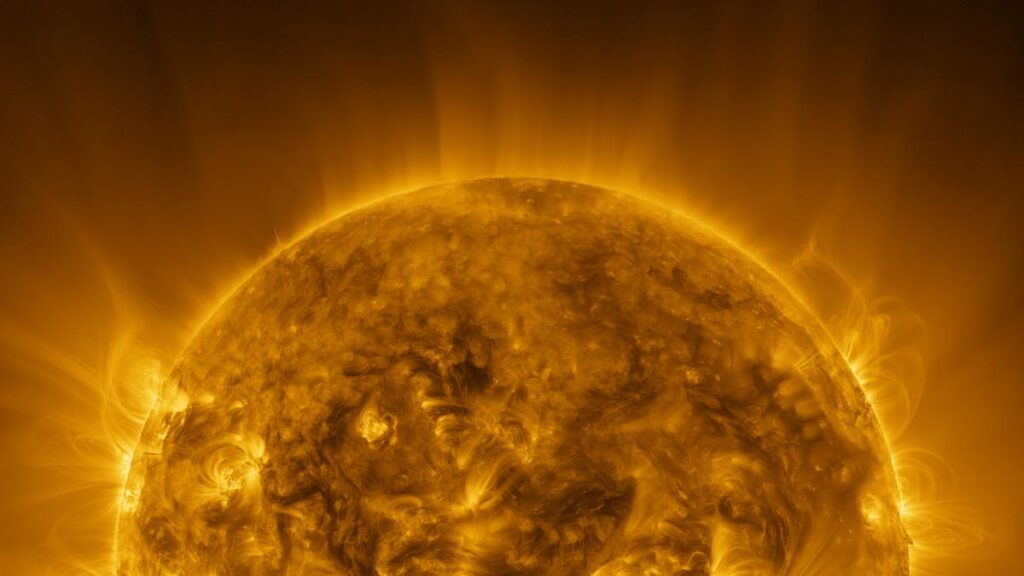
<span class=caption-credit> ESA & NASA/Solar Orbiter/EUI Team, E. Kraaikamp (ROB)</span>
Solar Orbiter Sun Image: Spectacular New High-Resolution View of Our Star Revealed
The new Solar Orbiter sun image reveals intricate details of the solar corona, magnetic field structures, and active regions | Credit: ESA & NASA/Solar Orbiter/EUI Team, E. Kraaikamp (ROB)
A breathtaking new Solar Orbiter sun image has been released by the European Space Agency (ESA) and NASA, showcasing our star in unprecedented detail. This remarkable high-resolution composite reveals intricate features of the Sun’s atmosphere, or corona, that are typically invisible to the human eye. The joint ESA-NASA mission continues to provide groundbreaking observations that are transforming our understanding of the Sun and its influence on our solar system.
Table of Contents
Inside the New Solar Orbiter Sun Image
The latest Solar Orbiter sun image reveals a mesmerizing view of our nearest star, capturing delicate structures that are normally hidden from view. The photograph showcases spun-sugar-like particles trapped within the Sun’s complex magnetic field, creating ethereal patterns throughout the corona. Dark filaments of cooler material can be seen weaving between bursting active regions, areas known to emit powerful solar flares and energetic particles into space.
Key Features Visible in the Solar Orbiter Sun Image
- Corona Structures: Intricate magnetic field patterns in the Sun’s atmosphere
- Dark Filaments: Cooler material suspended in the corona by magnetic forces
- Active Regions: Areas of intense magnetic activity that can produce solar flares
- Prominence Formations: Massive structures of plasma extending outward from the Sun
- Coronal Loops: Arching structures following magnetic field lines
What makes this Solar Orbiter sun image particularly significant is how it captures the entire solar disk in such extraordinary detail. The image reveals the Sun’s dynamic nature, showing regions of varying temperature and activity across its surface and atmosphere. These observations are crucial for scientists studying solar behavior and its impacts on space weather that can affect Earth’s technology and infrastructure.
Technology Behind the Capture
The remarkable Solar Orbiter sun image was captured using the spacecraft’s Extreme Ultraviolet Imager (EUI), a specialized instrument designed to observe the Sun in wavelengths invisible to the human eye. This technology allows scientists to peer through the outer layers of the Sun and observe phenomena that would otherwise remain hidden.
Extreme Ultraviolet Imager Capabilities
- Wavelength Observation: Captures extreme ultraviolet radiation emitted by the Sun
- Temperature Range: Observes plasma at temperatures from 20,000 to over 2 million degrees Celsius
- Resolution: Provides unprecedented detail of solar structures
- Field of View: Capable of capturing the entire solar disk
- Data Collection: Transmits detailed imagery back to Earth for scientific analysis
When capturing this Solar Orbiter sun image, the spacecraft was positioned approximately 77 million kilometers from the Sun—roughly halfway between Earth and our star. This strategic vantage point allows the Solar Orbiter to observe details that are impossible to see from Earth while remaining at a safe distance from the Sun’s intense heat and radiation.
Creating the Composite Image
The stunning Solar Orbiter sun image is actually a composite created from approximately 200 separate photographs taken by the EUI instrument. ESA scientists meticulously combined these images to produce the comprehensive view of our star that has captivated both the scientific community and the general public.
The process of creating such a detailed Solar Orbiter sun image requires sophisticated image processing techniques to align and blend the individual frames. Each component image captures a different section of the Sun, and when combined, they reveal the complete solar disk in extraordinary detail. This approach allows for a level of resolution that would be impossible to achieve with a single photograph.
The Composite Process
To create this remarkable Solar Orbiter sun image, scientists followed several key steps:
- Capturing approximately 200 separate high-resolution images of different sections of the Sun
- Processing each image to enhance visibility of specific solar features
- Aligning the images to account for the Sun’s rotation during the observation period
- Carefully stitching the images together to create a seamless view
- Applying final adjustments to highlight key scientific details while maintaining visual accuracy
The result is a comprehensive view that combines scientific precision with stunning visual impact, making complex solar phenomena accessible to both researchers and the general public.
Scientific Insights from the Image
Beyond its visual appeal, the new Solar Orbiter sun image provides valuable scientific data that continues to enhance our understanding of solar physics. Since its launch in 2020, the Solar Orbiter mission has contributed significantly to solar science, with this latest image offering fresh insights into several key areas of research.
| Solar Phenomenon | Visibility in Image | Scientific Significance |
|---|---|---|
| Coronal Structures | Clearly visible throughout the image | Helps understand how the Sun’s magnetic field shapes the corona |
| Solar Filaments | Dark lines weaving across the surface | Provides information about magnetic field topology and stability |
| Active Regions | Bright areas indicating intense activity | Key to understanding solar flare and eruption mechanisms |
| Coronal Heating | Temperature variations across the corona | Offers clues to the long-standing coronal heating mystery |
| Solar Wind Origins | Features that may be sources of solar wind | Contributes to understanding how solar wind is accelerated |
One of the most significant scientific contributions of the Solar Orbiter sun image is its potential to enhance our understanding of solar wind—the stream of charged particles continuously flowing from the Sun that affects space weather throughout our solar system. Previous observations from the mission have already provided new insights into the mechanisms driving solar wind, and this latest image offers additional data points for researchers.
Solar Orbiter Mission Overview
The spacecraft responsible for this remarkable Solar Orbiter sun image is the product of a collaborative effort between ESA and NASA, launched in February 2020. The mission was designed to provide unprecedented close-up observations of the Sun, including the first-ever images of the Sun’s poles, which are difficult to observe from Earth.
Solar Orbiter Mission Facts
- Launch Date: February 10, 2020
- Mission Partners: European Space Agency (ESA) and NASA
- Orbit: Elliptical orbit bringing it as close as 42 million km to the Sun
- Planned Duration: Minimum of 7 years, with potential extensions
- Scientific Payload: 10 instruments, including remote sensing and in-situ measurement tools
- Heat Shield: Special heat shield capable of withstanding temperatures up to 500°C
The primary objectives of the mission that produced this Solar Orbiter sun image include investigating the heliosphere, studying solar wind, examining the Sun’s polar regions, and understanding the dynamics of the solar atmosphere. By achieving these goals, scientists hope to answer fundamental questions about how our star works and how it influences the entire solar system.
Previous Achievements and Discoveries
This isn’t the first time the Solar Orbiter has provided valuable data. Since its launch, the mission has consistently delivered remarkable Solar Orbiter sun images and scientific insights. Among its previous achievements are detailed observations of “campfires” on the Sun—mini solar flares that may contribute to coronal heating—and unprecedented views of solar activity.
Beyond its primary focus on the Sun, the spacecraft has also made observations of Venus during gravitational assist maneuvers designed to adjust its orbit. These flybys provided bonus scientific data while helping position the orbiter for optimal solar observations that resulted in images like the latest Solar Orbiter sun image.
Notable Previous Discoveries
- Identification of miniature solar flares nicknamed “campfires” that may help explain coronal heating
- Observations suggesting mechanisms for solar wind acceleration
- Detailed mapping of magnetic field structures in the solar atmosphere
- Measurements of solar particle events and their propagation through space
- Insights into Venus’s magnetosphere during spacecraft flybys
Future Observations and Research
As the Solar Orbiter mission continues, we can expect more stunning Solar Orbiter sun images and groundbreaking scientific data in the coming years. The spacecraft is scheduled to make increasingly close approaches to the Sun, potentially providing even more detailed views of our star’s features and behavior.
Scientists are particularly looking forward to upcoming observations of the Sun’s poles—regions that are difficult to study from Earth’s vantage point. These observations could provide crucial information about the Sun’s magnetic field reversal process, which occurs approximately every 11 years as part of the solar cycle.
The Future of Solar Research
This latest Solar Orbiter sun image represents just one step in our ongoing journey to understand our nearest star. As the mission continues and is complemented by other solar observatories like NASA’s Parker Solar Probe, scientists anticipate significant advances in several areas:
- More accurate space weather predictions that could protect satellites and power grids
- Better understanding of the solar cycle and its impacts on Earth’s climate
- Insights into fundamental plasma physics applicable to fusion energy research
- Improved models of stellar evolution based on detailed observations of our own star
- Enhanced knowledge of how solar activity shapes the entire heliosphere
For those interested in exploring the latest Solar Orbiter sun image in greater detail, the European Space Agency has created an interactive version on their website, complete with labels explaining the various regions and features visible in the photograph. This resource makes the complex science behind solar observations accessible to the general public while providing valuable reference material for researchers and educators.
As we continue to receive and analyze data from the Solar Orbiter mission, each new Solar Orbiter sun image and measurement brings us closer to understanding the complex dynamics of our life-giving star and its influence on our planet and solar system.





